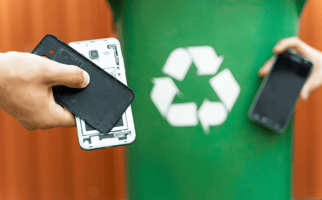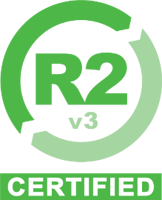In an increasingly digital world, the need for secure asset recycling is more crucial than ever....
A Simple Guide to IT Asset Recycling
In today's tech-driven world, IT assets are the backbone of modern businesses, fueling productivity and growth. However, with technological advancements accelerating, a troubling challenge has emerged: what happens to outdated or obsolete equipment? The rapid turnover of technology contributes to an ever-growing e-waste crisis, with the world generating over 53.6 million metric tons in 2019 alone. This staggering figure is expected to double by 2050, and only a fraction of these assets are recycled sustainably.
But there’s a silver lining: with proper recycling methods, not only can we mitigate these hazards, but we can also recover valuable materials such as gold, copper, and platinum. As responsible stewards of technology, it’s time for organizations to rethink their approach to IT asset management, ensuring sustainability isn't just an afterthought but a core part of their overall strategy.
Why Sustainable IT Asset Recycling Matters
Sustainable IT asset recycling matters for several reasons. First and foremost, it helps protect the environment. E-waste often contains hazardous materials like lead, mercury, and cadmium, which can leach into the soil and water, posing serious health risks. By recycling these materials properly, we can prevent pollution and reduce the harmful impact on our planet.
Secondly, sustainable recycling conserves natural resources. Many of the metals and materials used in electronic devices are finite. By recovering and reusing these resources, we can reduce the need for mining and extraction, which are energy-intensive processes that contribute to environmental degradation. This helps preserve our planet's resources and reduces the carbon footprint associated with producing new devices.
Additionally, there are economic benefits to consider. Proper recycling can lead to cost savings in the long run. By recovering valuable materials, companies can reduce their procurement costs for new components. Furthermore, many regions offer incentives or rebates for businesses that engage in sustainable practices, making it financially advantageous to prioritize recycling.
Finally, sustainable IT asset recycling fosters innovation. As organizations seek new ways to manage their e-waste, they may discover innovative recycling technologies and processes that can lead to new business opportunities. This not only drives economic growth but also encourages a culture of sustainability within the tech industry.
In conclusion, the importance of sustainable IT asset recycling cannot be overstated. It is essential for protecting the environment, conserving resources, enhancing corporate reputation, achieving economic savings, and fostering innovation. As we move forward in an increasingly digital world, it is crucial for organizations to integrate sustainability into their IT asset management strategies, ensuring a healthier planet for future generations.
Steps for Sustainable IT Asset Recycling
1. Assess and Inventory Your Assets
Before recycling, take stock of your IT assets. Create an inventory that includes details like the type, condition, and location of each item. This helps in deciding whether to recycle, reuse, or refurbish the equipment.
Helpful Tip: Use an asset management software or a simple spreadsheet to record information about each device.
2. Securely Erase Data
Before recycling IT assets, ensure that all data is securely erased to protect sensitive information. Simply deleting files is not enough, as data can often be recovered. Use specialized data-wiping software or services to completely erase data from hard drives and other storage devices.
Helpful Tip: Follow best practices for data destruction, such as using data erasure tools that comply with industry standards. You can review organization’s standards like NAID or r2v3.
3. Determine Reuse or Refurbishment Potential
Some IT equipment may still be useful. Consider refurbishing or repurposing items that are still functional. Donate or sell these assets to extend their lifecycle and reduce waste.
Helpful Tip: Partner with organizations that refurbish and reuse IT equipment, or donate to local charities, schools, or non-profits. Be sure if you’re using a ITAD provider that they are certified and have downstream partners that they trust
4. Choose a Certified E-Waste Recycler
For items that cannot be reused or refurbished, find a certified e-waste recycler. Look for recyclers with certifications such as R2 (Responsible Recycling) or e-Stewards, which ensure environmentally responsible recycling practices.
Helpful Tip: Research and select recycling companies that follow best practices for handling e-waste. If you’re using an ITAD partner, they likely partner with secure recyclers and you can utilize that relationship. Some ITAD providers may even be recyclers themselves.
5. Understand and Follow Local Regulations
Different regions have various regulations for e-waste disposal. Make sure to follow local laws and guidelines for recycling IT assets. This may include specific requirements for handling, transporting, and disposing of electronic waste.
Helpful Tip: Check with local government agencies or environmental organizations for information on e-waste regulations in your area. You can find your state electronics law here
6. Transporting Your IT Assets
When preparing IT assets for recycling, ensure they are transported safely. Use appropriate packaging to protect the equipment and prevent damage during transport. If using a recycling service, verify that they handle transportation and disposal in compliance with environmental regulations.
Helpful Tip: Contact your chosen recycler to understand their requirements for packaging and transporting e-waste. See if they have transparency and tracking capabilities so you know where your assets are all the time.
7. Document and Track the IT Asset Recycling Process
Keep records of the recycling process, including certificates of destruction and disposal. This documentation is important for compliance, auditing, and tracking the proper disposal of e-waste. If your provider cannot provide you with a certificate of destruction, then you need to find a different provider.
Helpful Tip: Request and retain certificates of destruction from the recycler to confirm that your IT assets have been properly processed. Keep all documentation from your recycler to ensure you can prove your assets were properly disposed of.
Benefits of Sustainable IT Asset Recycling
Beyond the obvious ecological benefits, such as reducing the toxic impact of e-waste on our landfills and water system, sustainable recycling opens doors to a wealth of opportunities that savvy businesses can't afford to ignore.
First and foremost, secure data destruction through responsible recycling methods protects companies from costly data breaches and regulatory penalties. It's a critical layer of defense, ensuring that confidential information doesn’t fall into the wrong hands.
Additionally, the financial gains are significant. Many discarded IT assets contain valuable materials like gold, silver, and copper, which can be recovered and reused, turning waste into a tangible revenue stream. This not only offsets disposal costs but can also contribute to a company’s bottom line.
Compliance is another vital benefit. As e-waste regulations become more stringent worldwide, companies that proactively embrace sustainable recycling are not only avoiding potential fines but also positioning themselves as leaders in responsible business practices. This commitment bolsters brand reputation, enhancing relationships with customers, investors, and stakeholders who prioritize sustainability.
Ultimately, sustainable IT recycling is about participating in a circular economy—extending the lifecycle of technology, reducing raw material extraction, and conserving resources. Forward-thinking companies recognize that this approach isn’t just about doing good; it’s about doing smart business, staying ahead of the curve, and driving meaningful change.
Conclusion
Sustainable IT asset recycling is an essential practice for protecting the environment and efficiently managing resources. By assessing and inventorying assets, securely erasing data, choosing certified recyclers, and following local regulations, you can ensure that your IT equipment is recycled responsibly. Promoting these practices within your organization not only helps the planet but also aligns with legal requirements and corporate sustainability goals. Implement these steps to contribute to a greener future and make a positive impact on the environment.
If your company is overwhelmed with your IT assets and needs help sustainably disposing of your IT assets, Synetic can help. Synetic Technologies offers a seamless, secure, and sustainable solution for IT asset recycling. We ensure that all data is completely destroyed using certified processes, protecting your business from potential breaches, while following eco-friendly practices to recycle e-waste responsibly. Our expertise doesn’t just protect the environment—it helps you recover value from your retired assets through our refurbishment and resale programs, turning your old equipment into a new revenue stream.
With Synetic Technologies, you also benefit from our deep understanding of regulatory compliance, ensuring your company meets all industry standards and environmental laws. Partnering with us means choosing a solution that delivers security, sustainability, and financial gain. Visit Synetic Technologies to discover how we can transform your IT asset recycling strategy.
-min.jpg?width=50&name=Ron%20Helmer%20(Default%20-%20Output%202)-min.jpg)


